
Ringo poses for us in the middle of “his” studio, which he shares with our friend Damien Olsen. We see multiple Korg keyboard synths, a Waldorf Blofeld, Line 6 pedal, and more. We also see some of Damien’s artwork hanging on the wall.
Some thoughts from Ringo:
“I like more sardines than contemporary electronica.
For me the golden age of electronic music is the 70s and the 90s, not crazy about the 80s.
and the last 25 years totally sucks, too much technology,
ego and noise, poor imagination”







